Input interpretation

Cl_2 chlorine + HBr hydrogen bromide ⟶ HCl hydrogen chloride + Br_2 bromine
Balanced equation
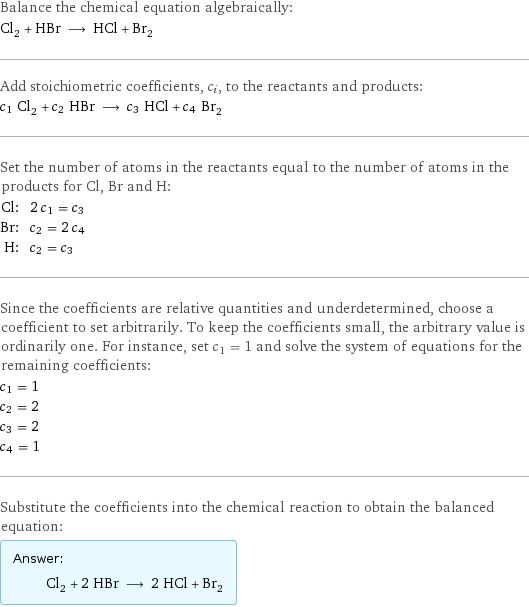
Balance the chemical equation algebraically: Cl_2 + HBr ⟶ HCl + Br_2 Add stoichiometric coefficients, c_i, to the reactants and products: c_1 Cl_2 + c_2 HBr ⟶ c_3 HCl + c_4 Br_2 Set the number of atoms in the reactants equal to the number of atoms in the products for Cl, Br and H: Cl: | 2 c_1 = c_3 Br: | c_2 = 2 c_4 H: | c_2 = c_3 Since the coefficients are relative quantities and underdetermined, choose a coefficient to set arbitrarily. To keep the coefficients small, the arbitrary value is ordinarily one. For instance, set c_1 = 1 and solve the system of equations for the remaining coefficients: c_1 = 1 c_2 = 2 c_3 = 2 c_4 = 1 Substitute the coefficients into the chemical reaction to obtain the balanced equation: Answer: | | Cl_2 + 2 HBr ⟶ 2 HCl + Br_2
Structures

+ ⟶ +
Names

chlorine + hydrogen bromide ⟶ hydrogen chloride + bromine
Reaction thermodynamics
Enthalpy
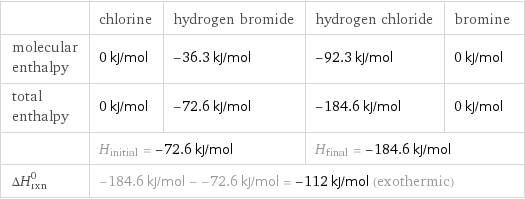
| chlorine | hydrogen bromide | hydrogen chloride | bromine molecular enthalpy | 0 kJ/mol | -36.3 kJ/mol | -92.3 kJ/mol | 0 kJ/mol total enthalpy | 0 kJ/mol | -72.6 kJ/mol | -184.6 kJ/mol | 0 kJ/mol | H_initial = -72.6 kJ/mol | | H_final = -184.6 kJ/mol | ΔH_rxn^0 | -184.6 kJ/mol - -72.6 kJ/mol = -112 kJ/mol (exothermic) | | |
Gibbs free energy
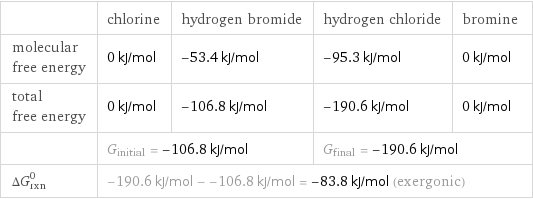
| chlorine | hydrogen bromide | hydrogen chloride | bromine molecular free energy | 0 kJ/mol | -53.4 kJ/mol | -95.3 kJ/mol | 0 kJ/mol total free energy | 0 kJ/mol | -106.8 kJ/mol | -190.6 kJ/mol | 0 kJ/mol | G_initial = -106.8 kJ/mol | | G_final = -190.6 kJ/mol | ΔG_rxn^0 | -190.6 kJ/mol - -106.8 kJ/mol = -83.8 kJ/mol (exergonic) | | |
Entropy
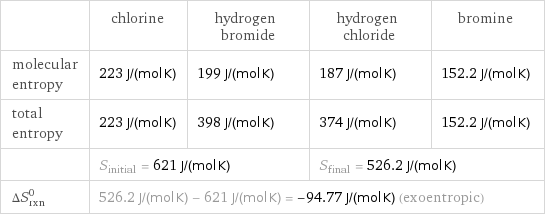
| chlorine | hydrogen bromide | hydrogen chloride | bromine molecular entropy | 223 J/(mol K) | 199 J/(mol K) | 187 J/(mol K) | 152.2 J/(mol K) total entropy | 223 J/(mol K) | 398 J/(mol K) | 374 J/(mol K) | 152.2 J/(mol K) | S_initial = 621 J/(mol K) | | S_final = 526.2 J/(mol K) | ΔS_rxn^0 | 526.2 J/(mol K) - 621 J/(mol K) = -94.77 J/(mol K) (exoentropic) | | |
Equilibrium constant
![Construct the equilibrium constant, K, expression for: Cl_2 + HBr ⟶ HCl + Br_2 Plan: • Balance the chemical equation. • Determine the stoichiometric numbers. • Assemble the activity expression for each chemical species. • Use the activity expressions to build the equilibrium constant expression. Write the balanced chemical equation: Cl_2 + 2 HBr ⟶ 2 HCl + Br_2 Assign stoichiometric numbers, ν_i, using the stoichiometric coefficients, c_i, from the balanced chemical equation in the following manner: ν_i = -c_i for reactants and ν_i = c_i for products: chemical species | c_i | ν_i Cl_2 | 1 | -1 HBr | 2 | -2 HCl | 2 | 2 Br_2 | 1 | 1 Assemble the activity expressions accounting for the state of matter and ν_i: chemical species | c_i | ν_i | activity expression Cl_2 | 1 | -1 | ([Cl2])^(-1) HBr | 2 | -2 | ([HBr])^(-2) HCl | 2 | 2 | ([HCl])^2 Br_2 | 1 | 1 | [Br2] The equilibrium constant symbol in the concentration basis is: K_c Mulitply the activity expressions to arrive at the K_c expression: Answer: | | K_c = ([Cl2])^(-1) ([HBr])^(-2) ([HCl])^2 [Br2] = (([HCl])^2 [Br2])/([Cl2] ([HBr])^2)](../image_source/2eab56849d8d344745e46483577fbd05.png)
Construct the equilibrium constant, K, expression for: Cl_2 + HBr ⟶ HCl + Br_2 Plan: • Balance the chemical equation. • Determine the stoichiometric numbers. • Assemble the activity expression for each chemical species. • Use the activity expressions to build the equilibrium constant expression. Write the balanced chemical equation: Cl_2 + 2 HBr ⟶ 2 HCl + Br_2 Assign stoichiometric numbers, ν_i, using the stoichiometric coefficients, c_i, from the balanced chemical equation in the following manner: ν_i = -c_i for reactants and ν_i = c_i for products: chemical species | c_i | ν_i Cl_2 | 1 | -1 HBr | 2 | -2 HCl | 2 | 2 Br_2 | 1 | 1 Assemble the activity expressions accounting for the state of matter and ν_i: chemical species | c_i | ν_i | activity expression Cl_2 | 1 | -1 | ([Cl2])^(-1) HBr | 2 | -2 | ([HBr])^(-2) HCl | 2 | 2 | ([HCl])^2 Br_2 | 1 | 1 | [Br2] The equilibrium constant symbol in the concentration basis is: K_c Mulitply the activity expressions to arrive at the K_c expression: Answer: | | K_c = ([Cl2])^(-1) ([HBr])^(-2) ([HCl])^2 [Br2] = (([HCl])^2 [Br2])/([Cl2] ([HBr])^2)
Rate of reaction
![Construct the rate of reaction expression for: Cl_2 + HBr ⟶ HCl + Br_2 Plan: • Balance the chemical equation. • Determine the stoichiometric numbers. • Assemble the rate term for each chemical species. • Write the rate of reaction expression. Write the balanced chemical equation: Cl_2 + 2 HBr ⟶ 2 HCl + Br_2 Assign stoichiometric numbers, ν_i, using the stoichiometric coefficients, c_i, from the balanced chemical equation in the following manner: ν_i = -c_i for reactants and ν_i = c_i for products: chemical species | c_i | ν_i Cl_2 | 1 | -1 HBr | 2 | -2 HCl | 2 | 2 Br_2 | 1 | 1 The rate term for each chemical species, B_i, is 1/ν_i(Δ[B_i])/(Δt) where [B_i] is the amount concentration and t is time: chemical species | c_i | ν_i | rate term Cl_2 | 1 | -1 | -(Δ[Cl2])/(Δt) HBr | 2 | -2 | -1/2 (Δ[HBr])/(Δt) HCl | 2 | 2 | 1/2 (Δ[HCl])/(Δt) Br_2 | 1 | 1 | (Δ[Br2])/(Δt) (for infinitesimal rate of change, replace Δ with d) Set the rate terms equal to each other to arrive at the rate expression: Answer: | | rate = -(Δ[Cl2])/(Δt) = -1/2 (Δ[HBr])/(Δt) = 1/2 (Δ[HCl])/(Δt) = (Δ[Br2])/(Δt) (assuming constant volume and no accumulation of intermediates or side products)](../image_source/136e4e45614c220bb8f38bfec89cb6e7.png)
Construct the rate of reaction expression for: Cl_2 + HBr ⟶ HCl + Br_2 Plan: • Balance the chemical equation. • Determine the stoichiometric numbers. • Assemble the rate term for each chemical species. • Write the rate of reaction expression. Write the balanced chemical equation: Cl_2 + 2 HBr ⟶ 2 HCl + Br_2 Assign stoichiometric numbers, ν_i, using the stoichiometric coefficients, c_i, from the balanced chemical equation in the following manner: ν_i = -c_i for reactants and ν_i = c_i for products: chemical species | c_i | ν_i Cl_2 | 1 | -1 HBr | 2 | -2 HCl | 2 | 2 Br_2 | 1 | 1 The rate term for each chemical species, B_i, is 1/ν_i(Δ[B_i])/(Δt) where [B_i] is the amount concentration and t is time: chemical species | c_i | ν_i | rate term Cl_2 | 1 | -1 | -(Δ[Cl2])/(Δt) HBr | 2 | -2 | -1/2 (Δ[HBr])/(Δt) HCl | 2 | 2 | 1/2 (Δ[HCl])/(Δt) Br_2 | 1 | 1 | (Δ[Br2])/(Δt) (for infinitesimal rate of change, replace Δ with d) Set the rate terms equal to each other to arrive at the rate expression: Answer: | | rate = -(Δ[Cl2])/(Δt) = -1/2 (Δ[HBr])/(Δt) = 1/2 (Δ[HCl])/(Δt) = (Δ[Br2])/(Δt) (assuming constant volume and no accumulation of intermediates or side products)
Chemical names and formulas
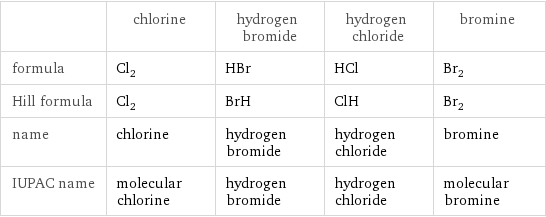
| chlorine | hydrogen bromide | hydrogen chloride | bromine formula | Cl_2 | HBr | HCl | Br_2 Hill formula | Cl_2 | BrH | ClH | Br_2 name | chlorine | hydrogen bromide | hydrogen chloride | bromine IUPAC name | molecular chlorine | hydrogen bromide | hydrogen chloride | molecular bromine